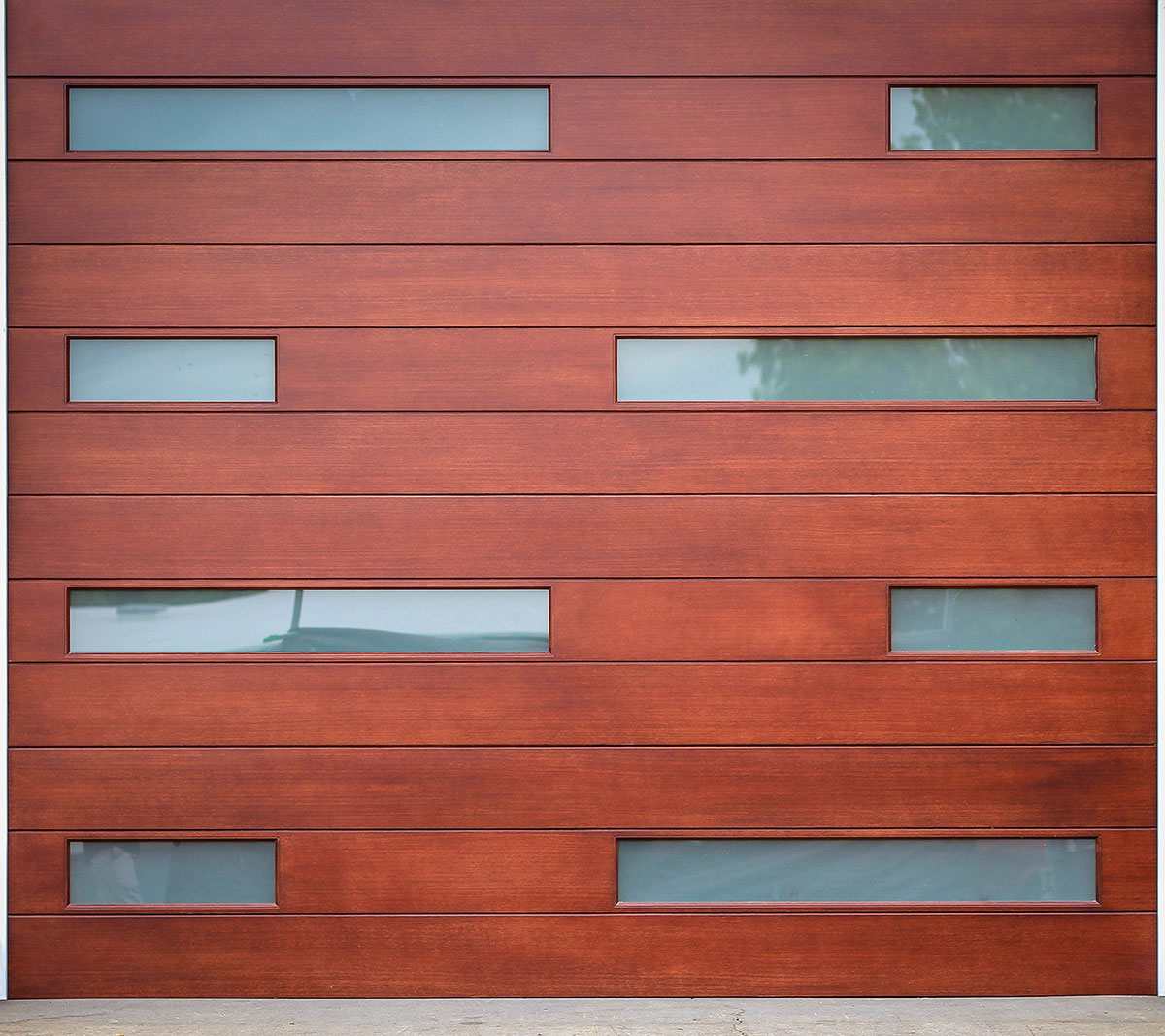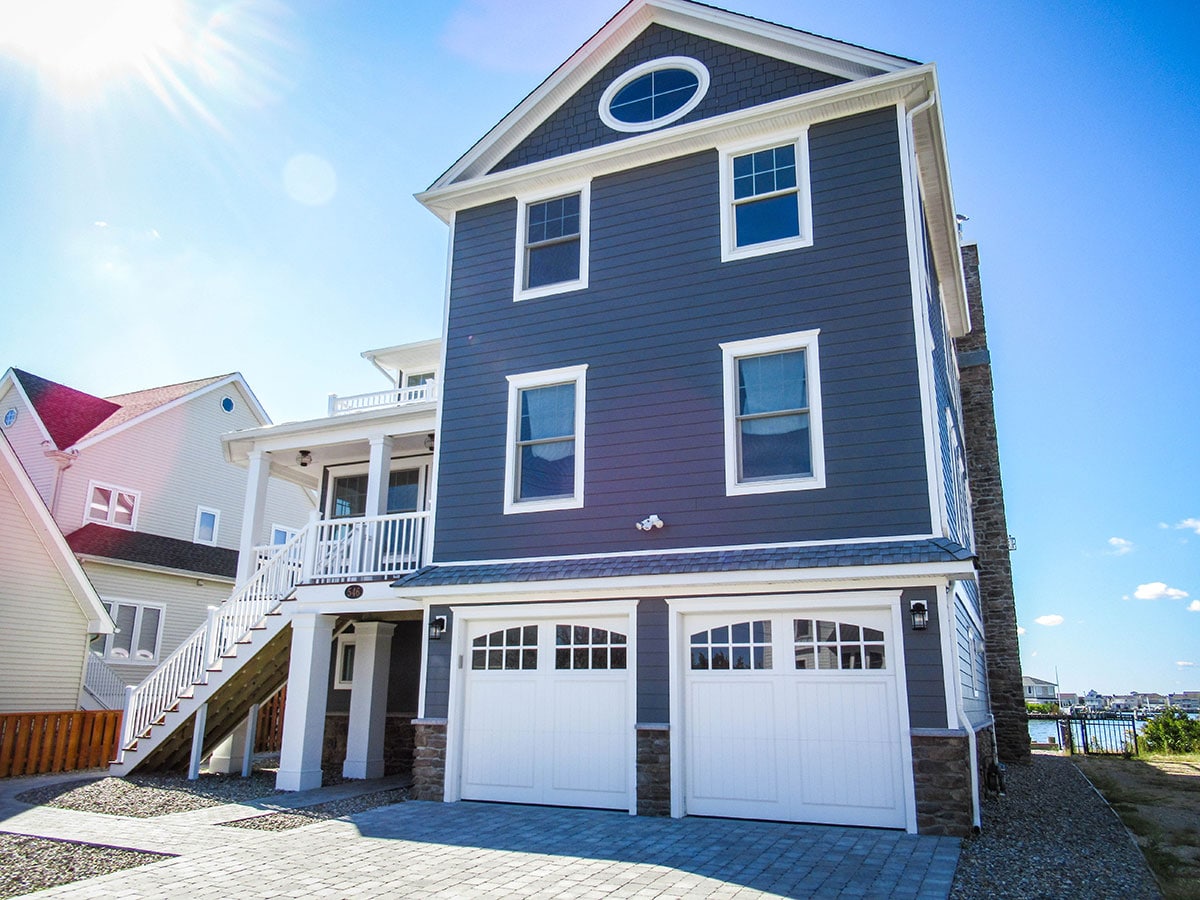The experts in family-run Fimbel Architectural Door Specialties tell us why vinyl doors are the most sustainable.

[Photo courtesy of Fimbel ADS]
The Fimbel family knows its garage doors. Ed Fimbel III, the outgoing CEO of Fimbel Architectural Door Specialties (Fimbel ADS)—whose daughter Erin is taking up the helm as company president alongside daughter and vice president Michaela—recalls the wood doors his grandfather made when the company was founded in 1924. He understands the evolution to steel in the 1970s and is resolute on the green benefits and strong aesthetics of vinyl and vinyl-clad doors they sell today.
But Fimbel cautions that at least one measure of garage door sustainability—the R-value used to report insulation properties—may not tell the story homeowners, builders, and architects want to hear. It’s a little more complicated than that.
Custom, High-End Doors
First, consider how garage doors have evolved into something visually important, and how sustainable manufacturing and longer-lasting products make for a better environment. This is not Fimbel’s father and grandfather’s company; it’s a whole new building world with higher expectations for quality and design.
FROM OUR JULY+AUG 2018 ISSUE

[Photo courtesy of Fimbel ADS]
Fimbel ADS’s higher-end doors can be made any way a customer wishes. Priced from $2,000 for a single door to $11,000 for a custom double—doors measure about 16 feet wide by 8 feet tall, but not every garage comes in a standard size, hence the need for customization—a Fimbel ADS door is recognized by architects and homeowners for playing a key role in curb appeal. “A garage door can constitute 30 to 40% of a home’s façade,” Ed says. Peruse the company’s catalog and you’ll see a range of styles—from carriage house swing doors to overhead doors in a variety of designs, including carriage house, traditional, modern, flush, and full custom. The array of options is especially important as people increasingly want something unique—no one wants to look just like their neighbor. Fortunately, Fimbel ADS’s cutting-edge construction methods and manufacturing techniques allow them to customize to make almost anything you could dream of.
“We always sold to a select, niche market of high-end customers,” Ed says. “But that changed in the 1990s. Middle class houses all looked the same. Garage doors are very large and most often face the street. There was value in upgrading from ‘plain Jane’ to something more architectural.” Today the company sells nearly 2,700 doors, manufactured in a plant that adjoins its Whitehouse, New Jersey headquarters with a second plant in McAdoo, Pennsylvania, each year in a good economy.
Green Benefits
From a sustainability standpoint, garage doors made of wood simply don’t make sense. Wood rots, particularly in wet and humid environments, resulting in more frequent replacements, Ed says. The garage doors made popular in the mid-20th century were made of steel, but steel rusts in the same places where wood rots. It also dents easily and has an undesirable fake woodgrain stamped into the face. Fortunately, there’s a better, more beautiful option. Fimbel ADS’s garage doors are made of petroleum-based vinyl (solid composite vinyl sheets and vinyl-clad steel), and that makes a lot more sense.
Chris Birdyshaw, vice president of sales and marketing for Fimbel (and also Ed’s son-in-law), explains why it’s the preferred, and greener, choice. “We use vinyl because it will not rot or rust,” he says. And while vinyl experiences seasonal expansion and contraction, it does so without cracking. The vinyl surface can also be painted in standard or specified colors and repainted as desired. “We also use top-grade components such as 11-gauge hinges,” Birdyshaw says, noting that the industry standard is the thinner 13-gauge material.
He says many high-end homes are using low-maintenance materials like cement board siding and vinyl trim boards, columns, and soffits. “Vinyl garage doors are a natural progression to that way of thinking,” Birdyshaw says. “Vinyl offers us the ability to make a high-end product with the look and feel of a wood door, but our doors are maintenance-free and can survive in harsh environments, like the coast, where a wood door would deteriorate.” Fimbel ADS also uses vinyl to make beautiful, intricate designs at a reasonable price and offers an expansive finishing program.
But those big doors are increasingly expected to offer temperature insulation, too—in part because garages are sometimes heated and often under a second story of the house. Some garages also house more parties than automobiles. The problem, the Fimbel family says, is that a simple R-value to indicate insulation presents a false story.
It has been said that an R-value of 6 is 91% energy-efficient and an R-value of 17 is 93% energy-efficient, so consumers don’t really need to get hung up on it, Birdyshaw says. Consider, for example, looking around the sides of your garage door from the inside. “You’ll probably see some daylight peeking through here and there. That’s normal because the door needs to be able to move,” he says.
Birdyshaw adds, “The only thing keeping the weather out are those pieces of molding with the rubber flap along the edge and the rubber on the bottom of the door. In truth, a consumer only needs an insulated door in areas where it gets fairly cold in the winter and only needs insulated glass if the garage is insulated/heated. The insulated glass is to prevent condensation—it doesn’t actually increase the R value very much at all.”

[Photo courtesy of Fimbel ADS]
Leading By Example
The embodied energy in the door manufacturing, as well as the green practices in Fimbel ADS’s administrative offices, contribute to their products’ green story. The company’s New Jersey headquarters and manufacturing plant draws 80% of electricity from solar panels on the roof. The company is also a member of the USGBC and had its operations successfully reviewed by The Institute for Green Business Certification on the basis of recycling, water and energy conservation, waste reduction, and environmentally friendly purchasing.
Birdyshaw attributes these sustainability initiatives to the newest generation of company leadership, Erin Fimbel. It would likely make her great-grandfather proud. “He always was waste conscious,” Ed says. “He burned wood scrap to heat the building.”

